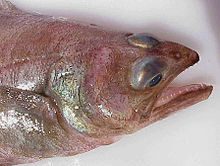
Salmon is the common name for several commercially important species of euryhaline ray-finned fish from the family Salmonidae, which are native to tributaries of the North Atlantic and North Pacific basin. Other closely related fish in the same family include trout, char, grayling, whitefish, lenok and taimen.

A tuna is a saltwater fish that belongs to the tribe Thunnini, a subgrouping of the Scombridae (mackerel) family. The Thunnini comprise 15 species across five genera, the sizes of which vary greatly, ranging from the bullet tuna up to the Atlantic bluefin tuna, which averages 2 m (6.6 ft) and is believed to live up to 50 years.

A flatfish is a member of the ray-finned demersal fish order Pleuronectiformes, also called the Heterosomata, sometimes classified as a suborder of Perciformes. In many species, both eyes lie on one side of the head, one or the other migrating through or around the head during development. Some species face their left sides upward, some face their right sides upward, and others face either side upward.

The United States Fish and Wildlife Service is an agency within the United States Department of the Interior dedicated to the management of fish, wildlife, and natural habitats. The mission of the agency is "working with others to conserve, protect, and enhance fish, wildlife, plants and their habitats for the continuing benefit of the American people."

Halibut is the common name for three flatfish in the genera Hippoglossus and Reinhardtius from the family of right-eye flounders and, in some regions, and less commonly, other species of large flatfish.
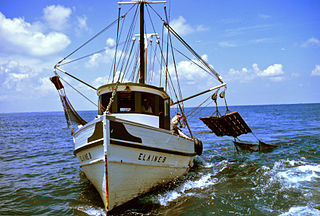
The fishing industry includes any industry or activity that takes, cultures, processes, preserves, stores, transports, markets or sells fish or fish products. It is defined by the Food and Agriculture Organization as including recreational, subsistence and commercial fishing, as well as the related harvesting, processing, and marketing sectors. The commercial activity is aimed at the delivery of fish and other seafood products for human consumption or as input factors in other industrial processes. The livelihood of over 500 million people in developing countries depends directly or indirectly on fisheries and aquaculture.

The chum salmon, also known as dog salmon or keta salmon, is a species of anadromous salmonid fish from the genus Oncorhynchus native to the coastal rivers of the North Pacific and the Beringian Arctic, and is often marketed under the trade name silverbrite salmon in North America. The English name "chum salmon" comes from the Chinook Jargon term tzum, meaning "spotted" or "marked"; while keta in the scientific name comes from Russian, which in turn comes from the Evenki language of Eastern Siberia. The term 'Dog Salmon' is most commonly used in Alaska and refers to the Salmon whose flesh Alaskans use to feed their dogs.
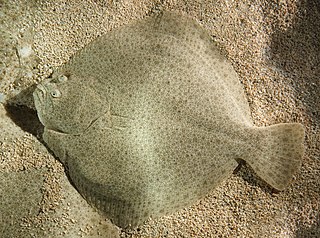
The turbot is a relatively large species of flatfish in the family Scophthalmidae. It is a demersal fish native to marine or brackish waters of the Northeast Atlantic, Baltic Sea and the Mediterranean Sea. It is an important food fish. Turbot in the Black Sea have often been included in this species, but are now generally regarded as separate, the Black Sea turbot or kalkan. True turbot are not found in the Northwest Atlantic; the "turbot" of that region, which was involved in the so-called "Turbot War" between Canada and Spain, is the Greenland halibut or Greenland turbot.

The United States Fish Commission, formally known as the United States Commission of Fish and Fisheries, was an agency of the United States government created in 1871 to investigate, promote, and preserve the fisheries of the United States. In 1903, it was reorganized as the United States Bureau of Fisheries, sometimes referred to as the United States Fisheries Service, which operated until 1940. In 1940, the Bureau of Fisheries was abolished when its personnel and facilities became part of the newly created Fish and Wildlife Service, under the United States Department of the Interior.
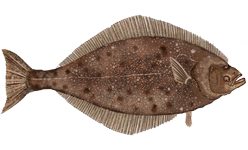
Hippoglossus stenolepis, the Pacific halibut, is a species of righteye flounder. This very large species of flatfish is native to the North Pacific and is fished by commercial fisheries, sport fishers, and subsistence fishers.

The barndoor skate is a species of marine cartilaginous fish in the skate family Rajidae of the order Rajiformes. It is native to the northwestern Atlantic Ocean, and is found from the Grand Banks of Newfoundland and the southern side of the Gulf of St. Lawrence south to North Carolina. The fish is one of the largest skates found in the North Atlantic Ocean, reaching lengths up to 1.5 m (5 ft). It is carnivorous, feeding on invertebrates and other fish found near the sea floor.
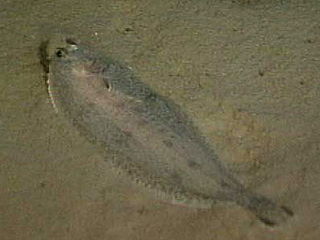
The witch, known in English by a variety of other common names including the witch flounder, pole flounder, craig fluke, Torbay sole, and grey sole, is a species of flatfish from the family Pleuronectidae. It occurs on both sides of the North Atlantic Ocean on muddy sea beds in quite deep water. In northern Europe it has some importance in fisheries as a food fish.

The Greenland halibut or Greenland turbot belongs to the family Pleuronectidae, and is the only species of the genus Reinhardtius. It is a predatory fish that mostly ranges at depths between 500 and 1,000 m (1,600–3,300 ft), and is found in the cold northern Atlantic, northern Pacific, and Arctic Oceans.

The Alaska pollock or walleye pollock is a marine fish species of the cod genus Gadus and family Gadidae.
This page is a list of fishing topics.

Atheresthes is a genus of righteye flounders native to the north Pacific Ocean where both species are important commercially.

The Kamchatka flounder, Atheresthes evermanni, is a flatfish of the family Pleuronectidae. It is a demersal fish that lives at depths of between 20 metres (66 ft) and 1,200 metres (3,900 ft). Its native habitat is the temperate waters of the northern Pacific. It can grow as long as 100 centimetres (39 in) in length, and can weigh up to 8.5 kilograms (19 lb).

The flathead sole is a flatfish of the family Pleuronectidae. It is a demersal fish that lives on soft, silty or muddy bottoms at depths of up to 1,050 metres (3,440 ft). Its native habitat is the northern Pacific, from the seas of Japan and Okhotsk, across the Bering Sea and to the coast of North America, as far south as Point Reyes, United States. It grows to 52 centimetres (20 in) in length, and can weigh up to 1.56 kilograms (3.4 lb); females are typically larger than males. Lifespan is at least 27 years for females and at least 30 years for males.
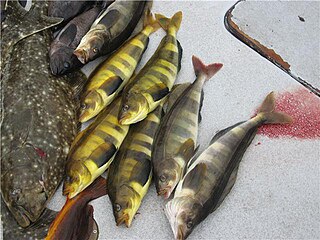
The Atka mackerel is a mackerel in the family Hexagrammidae. Atka mackerel are common in the northern Pacific ocean, and are one of only two members of the genus Pleurogrammus - the other being the Arabesque greenling. The Atka mackerel was named for Atka Island, the largest island of the Andreanof islands, a branch of the Aleutians.

The darkblotched rockfish is a species of marine ray-finned fish, a rockfish belonging to the subfamily Sebastinae of the scorpionfish family Scorpaenidae. This is a deepwater species of the North Pacific Ocean.
